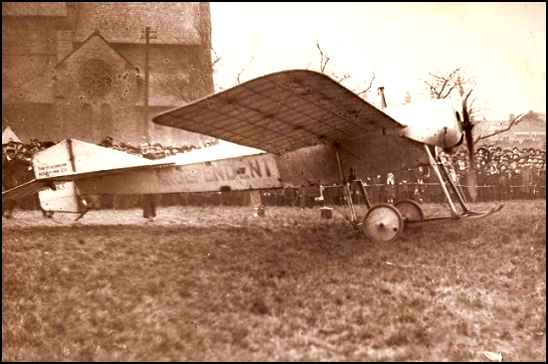
1913 |
 |
courtesy of Mike Hallett, 8-29-08 |
WARS OF THE ROSES AIR RACE
As explained in A.J. Jackson's 'Blackburn Aircraft since 1909': due to a number of pilot deaths resulting
from monoplane crashes, (not of Blackburn type; their machines had a reputation for sturdiness), the Air Ministry issued a ban on the
purchasing of monoplanes for the RFC. As Blackburn was keen to tender for Air Ministry contracts, he had perforce to build biplanes.
The Air Ministry rescinded this ban a few years later, but not before it spawned a generation of designers fixated on the biplane.
The superiority of the monoplane design is self-evident nowadays; it should also be noted that all birds are monoplanes! From Nick
Forder's description of the race it seems the two machines -- Blackburn monoplane and Avro biplane -- were evenly matched; I imagine
that as a biplane, the Avro had better low-speed handling characteristics, making it ideal as a trainer.Contributed by Mike Hallett, 8-29-08 Harold Blackburn was a flying instructor in the pre-war years and it may be this that led him to purchase an Avro 504 in July 1914. The following month war broke out and he joined the RFC. |
WARS OF THE ROSES AIR RACE
There has been a long standing rivalry between Lancashire and Yorkshire, which dates back to the
so-called War of the Roses when members of the House of Lancaster (represented by a red rose) fought members of the House of
York (white rose) for control of Fifteenth century England. Since then, the rivalry has become confined, largely, to sporting events. Contributed by Nick Forder On September 20, 1913, the Manchester firm of A V Roe (Avro) made a great impact on the aviation world with a new design which secured fourth place in the Aerial Derby. The importance of this result, and an average recorded speed of 66.5 mph, was that the Avro 504 was an untried prototype. The Yorkshire Evening News responded to the achievement of the Avro 504 by offering a trophy to the winner of an air race between the best Lancashire and best Yorkshire aeroplanes. This race was to be over a 100-mile course. Inevitably, the event was promoted as the War of the Roses Air Race. The foremost Yorkshire aviation company at this time was the Leeds-based Blackburn Aeroplane and Motor Company Limited. Prompted by the Yorkshire Evening News, Blackburn issued an official challenge to the Manchester- based A V Roe Company. This was accepted and the race was on. The Contenders : Avro 504 The basic layout, and some details, of the Avro 504 had been sketched out in a penny exercise book by A V Roe. Roe then gave the project to a team led by Roy Chadwick, who was later to become Chief Designer and be responsible for the Avro Lancaster. Chadwick and his assistant, C R Taylor, worked on the fuselage and undercarriage. Harry Broadsmith, a 23 year old former marine engineer, worked on the wings along with Frank Vernon. Vernon was a Whitworth Scholar who was employed primarily to undertake stress calculations; he had previously worked for the Locomotive Department of the Great Central Railway at Gorton in Manchester. There were clear similarities between this aircraft and the earlier Avro 500, particularly as regards the undercarriage and general shape, but the 504 featured wings with forward stagger and was powered by a new 80-hp Gnome rotary engine. Blackburn Type I Against this exciting new Avro, Robert Blackburn decided to race a new Type I two seat monoplane design. This was of a similar size to the Avro 504 (38 feet wing span as against 36 feet, and 28’ 6" long as against 29’ 5"), and was also powered by one of the new 80 hp Gnome engines. The Type I had been developed from the 1912 single-seater Blackburn Monoplane at the request of Dr M G Christie, a prominent member of the Yorkshire Aero Club. Christie had been very impressed by the 1912 Monoplane, an example of which is retained by the Shuttleworth Trust as the oldest surviving airworthy British aeroplane. However, he wanted a two-seater as, at that time, he had not qualified for his flying certificate. Therefore he employed Harold Blackburn to pilot the aircraft for him. This aircraft had been delivered to the Yorkshire Aerodrome, on Moortown near the centre of Leeds, on August 14, 1918. The Course It was agreed that the 100-mile course would be circular and flown over Yorkshire. Initial take-off and final landing points would be at the Yorkshire Aerodrome, of which Christie was a director. The start and finish line was to be Holroyd’s Intake on the main Leeds-Harrogate road. From there the aircraft would fly back over Moortown and then towards York. The aircraft had to land at checkpoints at York, Doncaster, Sheffield and Barnsley. At each checkpoint the aircraft had to remain on the ground for twenty minutes, presumably so the spectators had something to view. A Special Aerial Issue numbered edition of the Yorkshire Evening News was to be published for the race. Each aircraft had to carry fifty copies, which were to be distributed at each checkpoint. As both aircraft were two-seaters, it was decided that each would fly with a pilot and a passenger. The crew of the Blackburn consisted of Christie and Harold Blackburn. Fred Raynham, the Avro test pilot, was chosen to fly the Avro 504. A V Roe’s brother, Humphrey, elected to fly as Raynham’s passenger. The Race The day of the Race was October 2, and a large crowd gathered at the Yorkshire Aerodrome to see the start of the race. The French aviator, Henri Salmet, had been engaged to give exhibition and passenger flights to entertain the crowd while the two teams completed their preparations. The Race was to start just after 2:00 pm, and both aircraft ascended together to pass the start line at 2:14 pm. The Avro and the Blackburn were evenly matched on the flight towards York, with Raynham landing 25 minutes later, just a minute in front of Blackburn. The newspapers were duly unloaded, but the restart was slightly delayed when a small dog escaped from the crowd. Both aircraft were airborne again by 3:01 pm. Flying towards Doncaster, the pilots began to encounter patches of mist. They landed together at Doncaster, at 3:33 pm, and took off again eighteen minutes later. Once more mist was encountered, and visibility was seriously reduced. This caused more problems for Raynham because he was unfamiliar with the area over which he was flying. By the time he reached Sheffield, Blackburn was beginning to pull ahead and landed at 4:20 pm, four minutes before Raynham. Blackburn took over again at 4:42 pm and landed at the Barnsley checkpoint thirteen minutes later. He took off again at 5:19 pm, by which time Raynham had still not arrived. In fact, the Avro had flown over Barnsley in the mist and landed by mistake at Dewsbury. Realising their mistake, Raynham and Roe decided not to double back and instead flew on to Leeds. The Avro landed at 5:30 pm. Blackburn, having waited at Barnsley for twenty-four minutes, arrived at 5:48 pm. The Result The Yorkshire Evening News Challenge Trophy was awarded to the Yorkshire team, as the Lancashire team was disqualified for missing one of the checkpoints. As often happens when the result is not clear-cut, Lancastrians claimed that Blackburn’s local knowledge gave him an unfair advantage when attempting to identify landmarks in poor visibility conditions. Possibly this was the reason that it was agreed to repeat the event the following year, but this time over Lancashire. A course from Manchester to Blackpool, Liverpool and then back to Manchester was agreed. However, the outbreak of the Great War intervened and the whole idea was dropped. The Real Winner ? As far as the relative merits of the aircraft are concerned, it must be recognised that the Type I was one of the last of Robert Blackburn’s monoplane designs. The 504 established Avro as a successful aircraft manufacturer, saw extensive use both during the Great War and afterwards, and was still in production fifteen years later with a total of over 10 000 built. |
1913 |
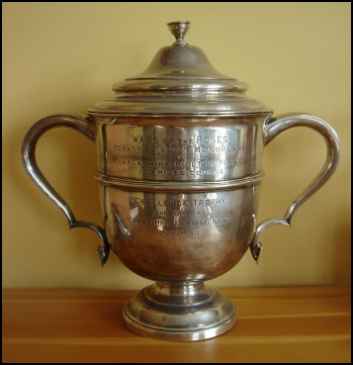 |
courtesy of Mike Hallett, 8-29-08 |
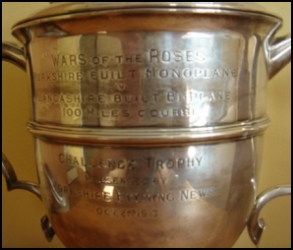 |
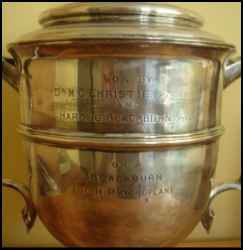 |
YORKSHIRE BUILT MONOPLANE & LANCASHIRE BUILT BIPLANE - 100 MILES COURSE CHALLENGE TROPHY PRESENTED BY YORKSHIRE EVENING NEWS OCT 2nd 1913 TROPHY - FRONT |
Dr M G CHRISTIE (PASSENGER) AND HAROLD BLACKBURN (PILOT) - ON A BLACKBURN 80 H P MONOPLANE YORKSHIRE EVENING NEWS TROPHY - BACK |
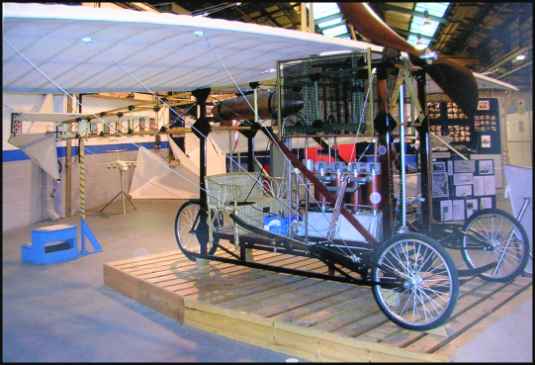 |
Built by the Brough Heritage Group via email courtesy of Joe, 2-19-06 I thought you would like this picture of the 1909 monoplane which we built. At the moment we are building a 1916 tri plane which will be ready in September. Best Wishes, Joe Brough Heritage Group Editor's Note: I thank Joe for this beautiful photograph of the replica and the news that they are building the 1916 tri plane replica. For a complete and detailed story of the activities of the Brough Heritage Group, visit the Blackburn Aircraft Company |


|